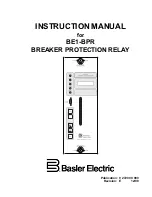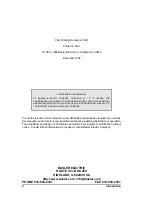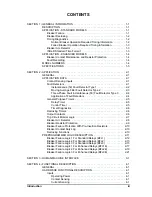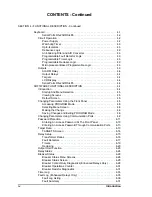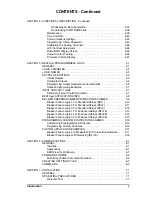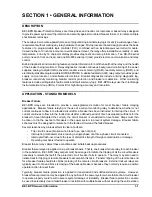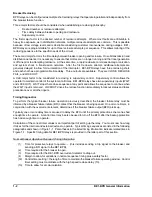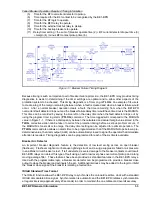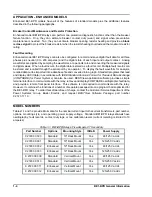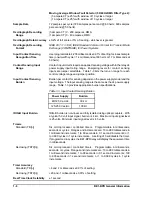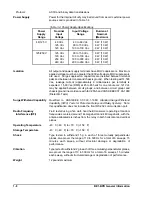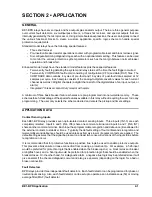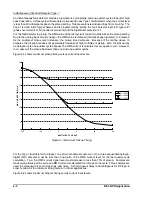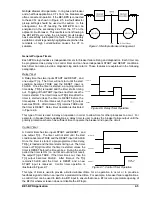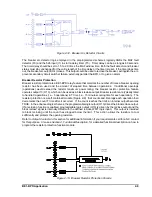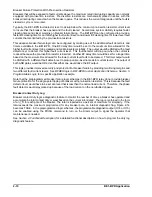
1-6
BE1-BPR General Information
Moving Average Window Fault Detector (50/60 Hz RMS Filter Type 2):
(5 ampere CT) ±25% with window of 10 cycles or larger
(1 ampere CT) ±25% with window of 10 cycles or larger
Sample Rate
12 samples per cycle (720 samples per second @ 60 hertz, 600 samples
per second @ 50 hertz).
Oscillograph Recording
Range
(5 ampere CT) 0 - 200 amperes, RMS.
(1 ampere CT) 0 - 40 amperes, RMS.
Oscillograph Data Accuracy
±0.2% of full scale or 5% of reading - whichever is greater
Oscillograph Recording
Format
IEEE C37.111-1991, IEEE Standard Common Format for Transient Data
Exchange (COMTRADE) for Power Systems.
Input Contact Sensing
Recognition Time
User programmable 4-255 milliseconds ±0.01% of setting to closest sample
time (one-twelfth cycle = 1.4 milliseconds at 60 hertz or 1.7 milliseconds at
50 hertz).
Contact Sensing Input
Range
Contact input circuits require an applied sensing voltage within the relay dc
power supply input rating range. Energizing levels for contact sensing
inputs are jumper selectable. Table 1-3 lists the turn-on range for each
control voltage range and jumper position.
Input Contact Sensing
Burden
Burden per contact for sensing depends on the power supply model and the
input voltage. The input sensing range is the same as the dc power supply
range. Table 1-3 provides appropriate burden specifications.
Table 1-3. Input Contact Sensing Burden
Power Supply
Burden
48/125 V ac/dc
30 k
6
125/250 V ac/dc
100 k
6
IRIG-B Input Burden
IRIG-B burden is non-linear and fully isolated using optical couplers. With
a typical 5.0 volt input signal, burden is 4 k
6
. Maximum input signal level
is 25 volts. Minimum input signal level is 4.5 volts.
Timers
Standard (TD[n])
Six microprocessor controlled timers. Programmable in milliseconds,
seconds or cycles. Ranges and increments are: 10 to 999 milliseconds in
1 millisecond increments; 1 to 60 seconds in 0.1 second increments; or 1
to 3,600 cycles in 1 cycle increments. A setting of 0 will disable the timer.
If programmed in cycles, the BE1-BPR relay will display the equivalent time
in milliseconds.
Reclosing (TD79[n])
Six microprocessor controlled timers. Programmable in milliseconds,
seconds, or cycles. Ranges and increments are: 10 to 999 milliseconds in
1 millisecond increments; 1 to 99 seconds in 0.1 second increments; 100
to 600 seconds in 1 second increments; or 1 to 9,999 cycles in 1 cycle
increments.
Timer Accuracy
Standard (TD[n])
+4 and -1 milliseconds ±0.01% of setting.
Reclosing (TD79[n])
+20 and -1 milliseconds ±0.01% of setting.
Real Time Clock Setability
±1 second
Summary of Contents for BE1-BPR
Page 31: ...BE1 BPR Application 2 17...
Page 42: ...3 4 BE1 BPR Human Machine Interface Figure 3 4 BE1 BPR Relay Vertical Mount Front View...
Page 43: ...BE1 BPR Human Machine Interface 3 5 Figure 3 5 BE1 BPR Relay Vertical Mount Rear View...
Page 49: ...4 6 BE1 BPR Functional Description Figure 4 2 Enhanced BE1 BPR Menu Display Screens...
Page 50: ...BE1 BPR Functional Description 4 7 Figure 4 3 Standard BE1 BPR Menu Display Screens...
Page 94: ...5 4 BE1 BPR BESTlogic Figure 5 1 BESTlogic Function Blocks...
Page 121: ...BE1 BPR Installation 7 3 Figure 7 3 Overall Dimensions Vertical Mount...
Page 122: ...7 4 BE1 BPR Installation Figure 7 4 Overall Dimensions Side View Vertical Mount...
Page 123: ...BE1 BPR Installation 7 5 Figure 7 5 Panel Drilling Diagram Vertical Mount...

